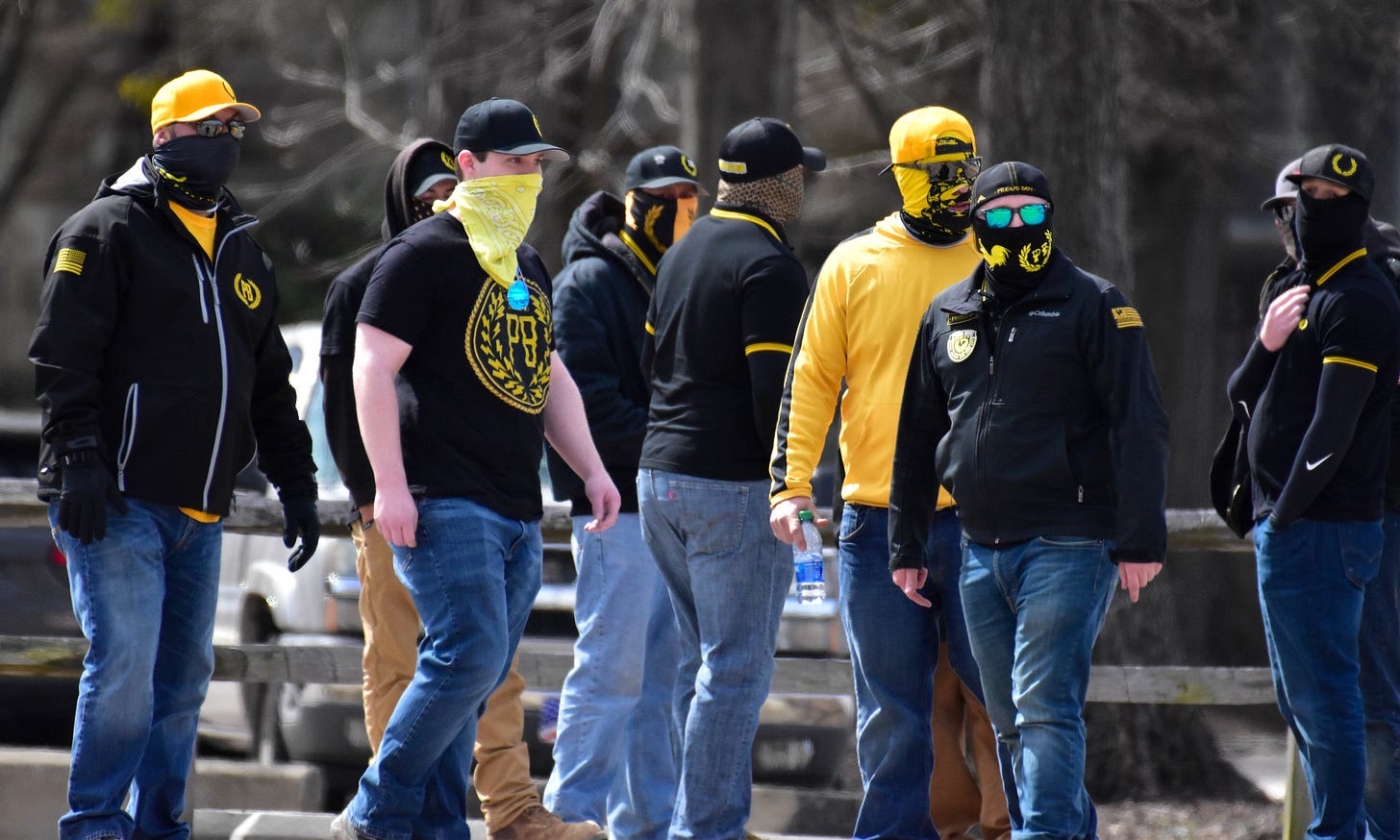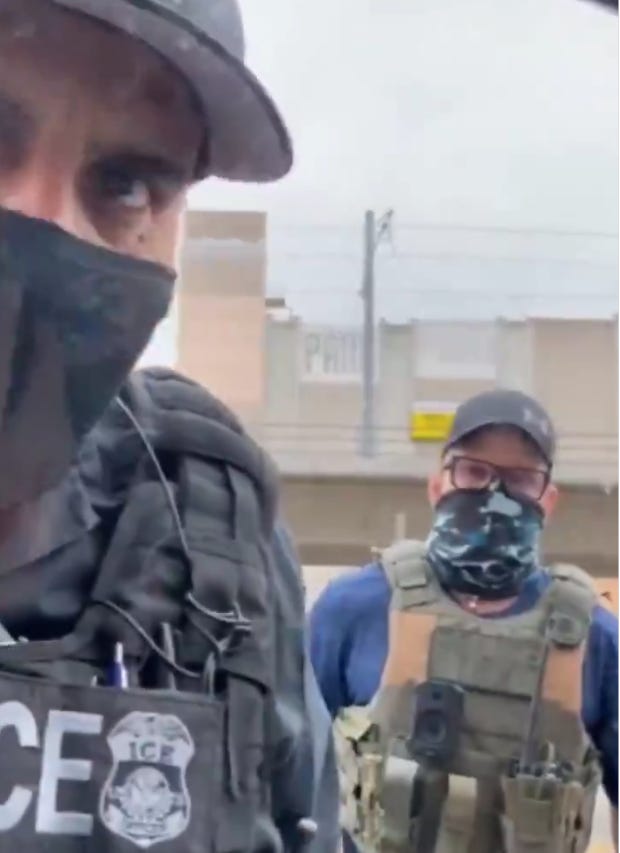Masked Men With Guns Are There to Keep Us All Afraid
Don't forget what's underneath.
As far as we know there was no single edict, no government-wide directive dictating a new policy. Yet it seems to have been adopted almost instantaneously: Government agents, especially but not only those from Immigration and Customs Enforcement, will now wear masks when prowling through American streets, raiding homes and workplaces, snatching people out of their cars, rounding up immigrants or people who look like immigrants, and carting them away in unmarked vehicles. These armed masked men are sometimes in uniform but often in plainclothes, with no visible identification or even an indication of which particular agency they work for.
This is something new in America. Until very recently, you probably associated the image of masked law enforcement with Mexican or Colombian police arresting a drug lord. Those are places and contexts in which the rule of law is so fragile — at least when they have to deal with the cartels — that police officers must hide their faces or risk being killed. But that is not what’s going on here. These agents aren’t taking down brutal drug kingpins; they’re seizing day laborers and housekeepers, or anyone else who happens to get in their way.
The Trump administration claims that if its agents were to go unmasked their own lives would be in danger. But that is simply preposterous; somehow we got through a couple hundred years of law enforcement without officers needing to cover their faces, so it’s hard to argue that the threat to those officers is greater now than it ever has been.
This image of masked men ready to do violence is everywhere now, just as the administration wants. The practical purpose is to remove the possibility of accountability, but there’s another message it sends: Unlike even previous iterations of state violence, this is a form of power with which there is no negotiating. When the masked men set upon you, you cannot appeal to the law, to your constitutional rights, to proper procedures, to legitimate authority. The men smashing your car window, grinding your face into the asphalt, yanking away your family members — these are not human beings in any legible way, because they have no faces. You cannot engage with them as one person to another, you cannot even know which agency they represent or what authority they are acting under. They are pure instruments of power.
This is why so many fictional portrayals of the brutality of authoritarian rule present the agents of the state as faceless. In film especially, that’s in part so you won’t mind when your hero kills them; it doesn’t matter how many Stormtroopers Luke and Han shoot, because they might as well be robots. But it’s also because, especially in the more simplistic portrayals, state power is supposed to be inhuman and undifferentiated, a giant machine that grinds people under its wheels almost without guidance from anyone but the leader and his small group of lieutenants.
But that’s not how it actually works. There are human beings all up and down the line; the work of oppression is complicated and requires a great deal of cooperation and maintenance (this, by the way, is part of what makes Andor possibly the best thing Star Wars has ever produced; it goes deep into the bureaucracy of the Empire).
Maybe we should call them the Greenshirts
As familiar as the mobilization of faceless law enforcement might seem (even if this is the first time we’re experiencing it on a large scale in America), it highlights something important about the Trump era. We spent a lot of time arguing during 2024 about whether Donald Trump could fairly be called “fascist,” and while the answer was clearly yes, one of the common elements of prior iterations of fascism was missing. Trump had allies among far-right paramilitary groups like the Proud Boys and Oath Keepers, many of whom came to Washington at his request to attempt to overthrow the government on January 6. But in 2024 through today — even though he pardoned them en masse — he wasn’t using them in any organized way to intimidate opponents and carry out violent actions as part of his governing project, like Hitler’s Brownshirts or Mussolini’s Blackshirts.
This is something I had assumed he would do, and maybe he still will. But so far he hasn’t had to, because not only ICE but other federal law enforcement, along with some officers from state and local agencies, have essentially been turned into Trump’s militia. That includes adopting the aesthetics of those far-right groups. This is a picture taken a few years ago; who do these guys remind you of?

The agents are human, and so are those they target
We have to remind ourselves that there are indeed human beings under those masks, not because we have to sympathize with them, but because it helps us understand how corrupting this whole enterprise is. Consider this video of a middle-aged landscaper named Narcisco Barranco being beaten by a group of at least half a dozen agents as he lies helpless on the pavement:
The one my eyes are drawn to is not the guy with his knee on Barranco’s neck, pummeling him about the head. It’s the agent on the left who snaps out his baton while shuffling his feet back and forth. Barranco is utterly helpless and no threat to any of them, but this guy is just itching to get in on the beating; the only reason he doesn’t use his baton is that it’s too crowded, what with all of them participating. After a few seconds he manages to position himself so he can give Barranco a kick in the ribs.
It’s important to keep highlighting the humanity of those who are being rounded up, because Trump has worked so hard to convince people that immigrants are not human at all, but are instead monsters and animals. To that end, here’s Barranco in happier times; all three of his sons have served in the Marines:
Finally, I want to highlight one more viral video, taken by an incredibly brave gentleman who followed a group of masked agents from his neighborhood. When they pulled him over, he simply refused to accept their power as without limit; he knew that he had the right to follow them down the street and monitor them. “I’m trying to see where you’re going, you’re kidnapping my neighbors,” he says.
When an unmasked Department of Homeland Security officer arrives, he and the driver have a civil conversation, one human being to another. They’re both calm and respectful, and they arrive at a reasonable conclusion, one consistent with the law: He’s free to go where he pleases, so long as he doesn’t physically interfere with the officers.
I’m not saying this is a formula we can all apply; masked officers are drawing guns on people and arresting bystanders, and that’s very frightening. But social media is full of videos of people confronting the agents, recording them, shouting at them, bringing out their neighbors to object together. This is the opposite of what the specter of the masked armed men is supposed to produce. It’s designed to make us feel not just afraid but powerless, as though the state’s authority and capacity for violence is so overwhelming that it cannot be resisted. But people across the country are refusing.
Thank you for reading The Cross Section. This site has no paywall, so I depend on the generosity of readers to sustain the work I present here. If you find what you read valuable and would like it to continue, consider becoming a paid subscriber.




I think they are all chickenspit cowards who have been given license to act out their schoolyard bully fantasies. As such it is my plan to treat them with disdain and plan the lawsuit that I will win if they try this shit on an old man. I also believe they are paid mercenaries from Blackwater, the Proud Boys, Oath Keepers and other militias and therefore subject to arrest and prosecution for everything from assault to kidnapping. And they will be. It's only a matter of time.
Great piece, Paul.